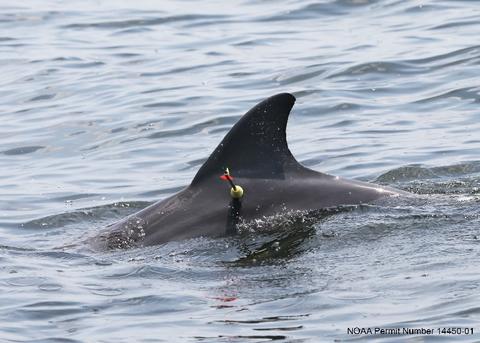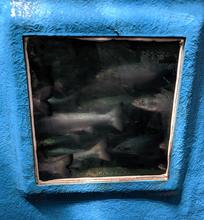Summary
The monitoring of wildlife and broodstock health through endocrine assessments is essential to understanding reproduction and stress. Collecting blood samples through traditional means can be difficult and may potentially alter hormone profiles. NIST works with stakeholders to develop measurement techniques for determining hormones in non-traditional and less invasive matrices for monitoring wildlife health and broodstock reproductive yields.
Description

Photograph of a swimming dolphin, breaking the surface of the water. A biopsy dart can be seen protruding next to the dorsal fin.
NIST collaborates with stakeholders to develop techniques for measuring hormone levels as part of animal health assessment. The process of capturing and transporting animals before sampling can induce stress, which may alter the hormone levels in the bloodstream. Therefore, the collection of blood samples may not be the most suitable option for certain species that are difficult to sample. As hormones are also present in other tissues, alternative sampling methods may exist that are less invasive and result in reduced stress for the animal. These methods potentially offer advantages in terms of ease and speed of sampling. By using less traditional matrices, samples can be obtained that provide a baseline representation of the animal's stress and reproductive profile. Different measurement challenges exist for different types of sample matrices, and reliable measurement techniques must be developed to ensure accurate analysis of alternative matrices with poorly known matrix interferences. NIST has worked to develop new methods for the determination of steroid hormones in nontraditional sample matrices using liquid chromatography tandem mass spectrometry.
Blubber for the Environmental Assessment of Contaminants and Steroids (BEAConS): In collaboration with the Marine Mammal Foundation and NOAA, NIST has developed new methods for remote monitoring of steroid hormones and contaminants in blubber. These methods help assess the reproductive health status and population dynamics of marine mammals. Under the Marine Mammal Protection Act of 1972, NOAA is responsible for monitoring marine mammal health. With a remotely sampled dart biopsy of blubber (weighing approximately 1 gram), it is possible to determine sex, reproductive status, stress status, and organic contaminant loads of a free-ranging cetacean. This method reduces the manpower and stress involved in blood collection for health and population assessment. NIST scientists have developed new mass spectrometry methods for measuring steroid hormone pathways in blubber using liquid chromatography tandem mass spectrometry. They can pair this with existing methods for persistent organic pollutants in blubber. This methodology provides a wealth of information from a single, relatively simple sample collection. It can help stakeholders investigate endocrine disruption of free-ranging species or assess reproductive success or stress status pre and post disruptive events.

Fish Mucus for Selection of Broodstock: Atlantic salmon commercial yields in the US have dropped in production more than 35% since 2000 due, in part, to decreased embryo survival rates. Reduced embryo survival is due to gamete quality which can be influenced by endocrine status of adult salmon. Currently, the Atlantic salmon endocrine profile has not been measured with respect to their reproductive fitness. Using a combination of untargeted metabolomics and targeted steroidomics, NIST is working to develop methods to identify biomarkers of fertility in Atlantic salmon using skin mucus, a less-invasive matrix that is known to contain reproductive hormones and other metabolites. By working with stakeholders, NIST will help to identify better biomarkers of fish fertility to aid in the identification of high-yield broodstock and increase production of this important food source.
RELATED PUBLICATIONS
1. Boggs, A. S., Ragland, J. M., Zolman, E. S., Schock, T. B., Morey, J. S., Galligan, T. M., Dalle Luche, G., Balmer, B. C., Wells, R. S., and Kucklick, J. R., "Remote blubber sampling paired with liquid chromatography tandem mass spectrometry for steroidal endocrinology in free-ranging bottlenose dolphins (Tursiops truncatus)," General and comparative endocrinology, 281, 164-172 (2019)
2. Galligan, T. M., Balmer, B. C., Schwacke, L. H., Bolton, J. L., Quigley, B. M., Rosel, P. E., Ylitalo, G. M., and Boggs, A. S., "Examining the relationships between blubber steroid hormones and persistent organic pollutants in common bottlenose dolphins," Environmental Pollution, 249, 982-991 (2019)
3. Galligan, T. M., Schwacke, L. H., Houser, D. S., Wells, R. S., Rowles, T., and Boggs, A. S., "Characterization of circulating steroid hormone profiles in the bottlenose dolphin (Tursiops truncatus) by liquid chromatographyGÇôtandem mass spectrometry (LCGÇôMS/MS)," General and comparative endocrinology, 263, 80-91 (2018)
4. Galligan, T. M., Schwacke, L. H., McFee, W. E., and Boggs, A. S., "Evidence for cortisol-cortisone metabolism by marine mammal blubber," Marine Biology, 165, 1-8 (2018)
5. Galligan, T. M., Boggs, A. S., Balmer, B. C., Rowles, T., Smith, C. R., Townsend, F., Wells, R. S., Kellar, N. M., Zolman, E. S., and Schwacke, L. H., "Blubber steroid hormone profiles as indicators of physiological state in free-ranging common bottlenose dolphins (Tursiops truncatus)," Comparative Biochemistry and Physiology Part A: Molecular & Integrative Physiology, 239, 110583 (2020)
6. Dalle Luche, G., Boggs, A. S. P., Kucklick, J. R., Gro+¦, J., Hawker, D. W., and Bengtson Nash, S., "Androstenedione and testosterone but not progesterone are potential biomarkers of pregnancy in Humpback Whales (Megaptera novaeangliae) approaching parturition," Scientific Reports, 10, 2954 (2020)

